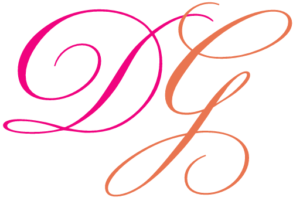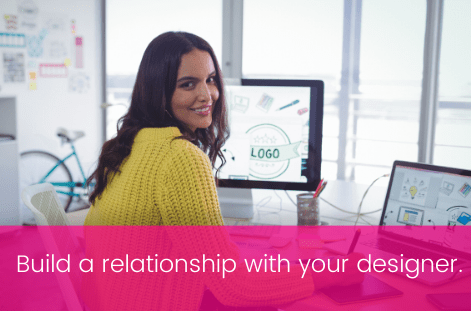When it comes to that perfect little black dress, or the custom-fitted suit, the perfect fit is literal. When it fits perfectly, we look and feel GREAT. But finding the perfect fit with the people who work on your brand is just as important. We know the right graphic designer is going to be a key component of creating a visual brand that is built from your brand messaging and vision. But how do you find the graphic designer you need to hire … the one who will be the perfect fit for you and your business?
In the blog post Who Does What in Website Creation, I outlined the various people who work on website creation. Today, I’m going to get specific about how to find the right graphic designer. I interviewed Carrie Coren of Carrie Coren Design to get the inside scoop on hiring the graphic designer with the perfect fit.
Meet Carrie Coren, Graphic Designer

First, let’s meet the graphic designer with whom I spoke, Carrie Coren. In her own words, she’s been doing graphic design since she was born. Her father was a highly creative commercial artist and that was a pivotal influence. Design and creativity were valued and were just part of her life. When she graduated college, she went to work in an ad agency. This afforded her the chance to work with great clients, build her skills, learn a ton, and develop her portfolio. In 2009, she launched Carrie Coren Design and has happily been providing graphic design services — from logos to billboards — for her clients ever since.
Q. What are the top questions clients ask when they reach out to you?
Honestly? Most are at a loss and don’t know what to ask. I end up guiding them through a conversation about design. The things I’m trying to discover is whether or not they know who their target audience is. Do they have a mission statement … basically all the brand messaging elements. I can’t create the right visuals or logo if I don’t have this information. And it is not the graphic designer’s job to create those things; that’s a marketing function.
Q. What are the top pitfalls or problems you encounter with new clients?
Too many opinions.
When the decision maker doesn’t have confidence in their decisions OR they’re getting too much input from their team. Each of these situations can muddy up the process. Getting input from a *few* key team members early in the process makes sense. But the creative process can’t be entirely democratic; someone needs to make the final decisions. When it comes to design, too many opinions slow the entire process down (which costs money) or the results end up watered-down and mediocre … and nobody wants that!
Lack of trust.
Another issue that I and many designers encounter is when the client doesn’t trust the professional they’ve hired. BUT, if the client has taken the time to ask all the right questions and had a good discovery conversation before hiring the designer, the designer should be the right person for the job. And if he/she isn’t, then the designer ought to decline the job if the client isn’t doing it for them. When we hire a professional, it’s incredibly helpful to the creative process if we can release some control and trust that individual to do the job we hired them to do.
DIY approach.
This issue is one that tends to happen with “new to business” or “just launching” entrepreneurs; those who have small to non-existent marketing budgets. It’s the “my nephew is going to create my logo” scenario. Your nephew may be a burgeoning and talented artist, but there’s more to a great logo than just making it pretty. A seasoned designer is going to understand how brand messaging informs a logo’s design and how certain things work for certain markets and industries and platforms. They’ll understand trends and color theory, etc. And more often than not, the in-school or just-out-of-school nephew isn’t ready to create an authentic, on-target visual brand all by himself.
Q. What questions do you want prospective clients to ask you, or any graphic designer?
What’s your experience? What specifically makes you great at creating a visual brand? What does working with you look like? Can you describe the process? Do you have testimonials or past clients I can talk with? What’s included in this project? What am I missing? They need to get to know me and how I work and what I deliver.

Q. What do you wish clients would know before they called a graphic designer?
Know their business.
Having a solid understanding of their business’ brand messaging. Knowing their objectives and goals, who their customer is, their unique value proposition, the problem(s) they are solving for their customers, and/or how they are helping their customers.
Their budget.
If I know their budget upfront, it’s easier for me to be clear about what I can do for them. If they haven’t thought about it, I can ask the right questions to learn what they’re looking to do. If there is NO budget or money for hiring a designer, letting me know that upfront changes the conversation. There’s nothing wrong with reaching out to get information. But if they’re unable to hire a designer now, then I can steer the conversation in a way that is helpful to them.
Future needs.
This is often overlooked by small businesses and/or entrepreneurs. If I create a logo, I need to know upfront if the client is planning on using it in multiple ways, which most businesses need. For example, brand consistency shows up when the logo looks as it should across all platforms — websites, business cards, social media, and billboards. But, one can’t take the website logo and make it work for a billboard or even a social platform. They need to be sized correctly. Nothing is worse for a designer than seeing a logo stretched out or pixelated because someone forced it where it doesn’t fit. It muddies the brand and design and can hurt the designer’s reputation.
It’s really great when a business owners understand the value of establishing a relationship with a designer. This way, if you need your logo to appear in an ad, or you’re creating event materials, your designer can ensure that everything is on brand and works the way you want and need it to do. If you buy a cheap logo from an online service, you’re not establishing a relationship. Over time, you’ll end up paying more — and in more ways than just money.

Q. Please describe an ideal logo design process.
We’ll start with a meeting that will run one to two hours. We’ll cover everything that I’ve already mentioned, and I’ll begin to get to know them as a person. Their personality could affect the logo, not always, but it might, just like the type of business can affect style.
After that discussion, I develop a minimum of three logo variations. I like to create three logos that I’d have a hard time choosing between. Additionally, I often include a tagline if they don’t have one. (Message Artist note — not many designers can offer this service!)
We meet again and I present the logos in a strategic order; I put my favorite last. We talk through each logo and this usually works to help the client land where I think is best. We talk about the logo and there are generally edits, usually about colors or tweaking the tagline. Most logo designs are final after three or four rounds of edits.
Once the logo is approved, then I prepare it in the different formats the client identified as needing. Granted, most people don’t think about all the ways a logo can be used. It’s really up to the designer to educate the client on how to use it. If your designer isn’t asking you all the ways you want to use it, that’s a red flag.

It all goes back to hiring someone with experience. Hiring someone with little experience or who is designing at a very low cost, well, it may cost less now, but you always get what you pay for. You’ll end up paying for the other versions anyway OR needing to have the logo redesigned.
Hiring the Graphic Designer
I want to say thank you again to Carrie for taking the time to fill us in on what to look for when it comes to hiring a designer. I’ll add this … for many small business owners and entrepreneurs, your relationship with your business is an intimate one. You don’t want to invite anyone who you don’t trust completely or feel comfortable with working on something as crucial as your visual brand.
You want a graphic designer who not only creates great logos and marketing pieces, but one that you can also see working with for a long time. Your designer should listen to you, but also question and push back if what you’re envisioning really isn’t the best choice for reasons of which you may not be aware. And when they do push back, they should be offering you another solution.
In the best scenario, you develop a relationship with your graphic designer that is founded on informative, creative, and productive dialogue … and results!
Have any branding questions? Schedule some time to chat and let’s get you some answers.



0 Comments